The air was redolent with the scent of death.
“Don’t run!,” our guide commanded. We were walking through the
Zambian bush, the mopane trees alive with vultures waiting for a crack at the
carrion — a massive Cape buffalo killed by lions who were feasting on their
hapless prey in a nearby thicket.
اضافة اعلان
My husband, Roger, and son, Gabe, and I were heading single file
toward the big cats. Leading the way was a National Parks scout armed with a
rifle who was forging a roundabout trail across a gully. My anxiety mounted
with every crunching leaf underfoot. We heard a slight “Grrrr” and soon spied a
lion’s silhouette flickering through the bushes. I thought grimly about being
dead meat. Then the wind shifted and the mighty beasts, picking up the scent of
the ultimate predator — humans — fled into the brush.
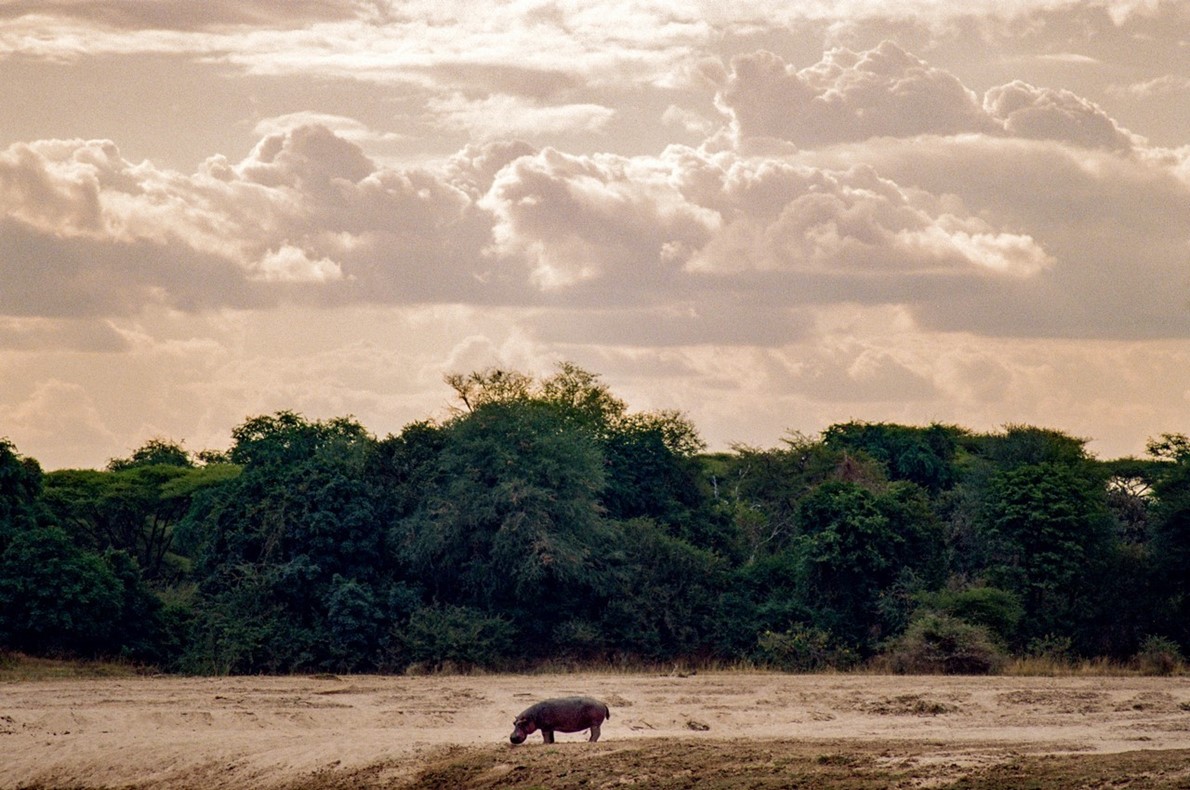 A hippopotamus along
the banks of the Mwaleshi River near Takwela, a safari camp in North Luangwa
National Park in Zambia, On January 24, 2023
A hippopotamus along
the banks of the Mwaleshi River near Takwela, a safari camp in North Luangwa
National Park in Zambia, On January 24, 2023
We had landed several days earlier on a dirt airstrip in one of
the most-remote and least-touristed parks in Africa — North Luangwa National
Park in Zambia — the tiny Cessna touching down on a smattering of impala
droppings. The huge park, just shy of the size of New Jersey, has few roads and
can accommodate only 400 or so visitors a year, at least for now (the safari
season runs May to mid-November).
On a three-week trip to Zambia, we visited two far-flung
national parks — North Luangwa and Kafue — which have both been on the front
lines of anti-poaching efforts. North Luangwa is home to the country’s only
population of black rhino, a species that was declared extinct in Zambia in
1998 because of heavy poaching; the cantankerous animals were reintroduced five
years later and are now thriving in a vast sanctuary jointly administered by
the Frankfurt Zoological Society and the Zambian Department of National Parks
and Wildlife.
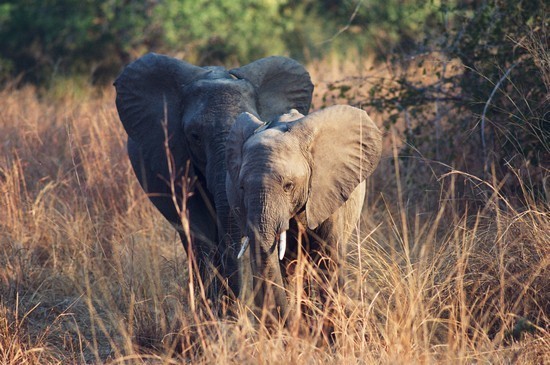 Elephants walk through brush in South Luangwa National Park
in Zambia, On January 23, 2023.
Elephants walk through brush in South Luangwa National Park
in Zambia, On January 23, 2023.
In each park, we focused on walking, with a few long game drives
in between. On foot, we were accompanied by a guide and an armed scout, as per
Zambian protocol, with a trainee guide in the rear. We traversed trails blazed
by hyena and other animals and teetered on the rims of deep ruts in the earth
created by elephants and hippos that had traipsed through the mud during rainy
season.
Kafue is Africa’s second-largest national park (the largest is Namib-Naukluff in Namibia) but only draws about 15,000 visitors a year.
I had previously traveled to South Luangwa National Park, the
North’s more accessible cousin. So I was familiar with Remote Africa Safaris,
an excellent family-run safari operation that specializes in tours in both
parks. In Kafue, they suggested Jeffrey & McKeith Safaris, another
owner-run operation, and we booked directly with both.
Our first camp in North Luangwa was Takwela, which is poised at
the confluence of the agate-colored Luangwa and the crystalline Mwaleshi
rivers. From 1,828m above in a Cessna, the Luangwa is a writhing snake of water
patterned with sandbars — a crocodile paradise. Just reaching the camp from the
airstrip requires deft maneuvering in a flat-bottomed boat around dozens of
submerged hippos, ears twitching above the surface. Their baritone chuckles, in
which they ho-ho-ho like deranged Santas, are not exactly endearing in the
middle of the night when the safari wake-up call is 5:30am.
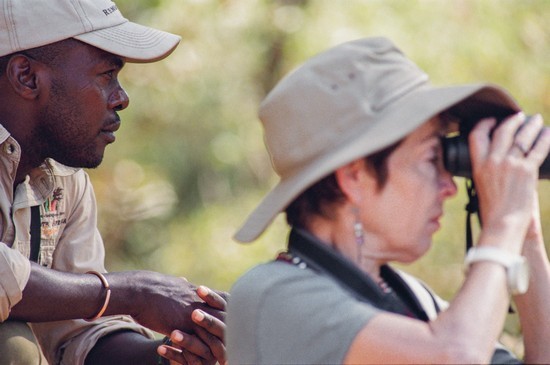 Moffat Mwanza, a
guide for Remote Africa Safaris, and reporter Patricia Leigh Brown in North
Luangwa National Park, On January 23, 2023.
Moffat Mwanza, a
guide for Remote Africa Safaris, and reporter Patricia Leigh Brown in North
Luangwa National Park, On January 23, 2023.
After a dawn breakfast around the campfire, we crossed the river
in preparation for a nearly 10km walk from Takwela to Mwaleshi, an even more
secluded camp on the Mwaleshi River within the rhino sanctuary. Driving to the
starting point, we shared the road with helmeted guinea fowl, speckled
blue-faced birds whose frantic movements bring to mind the Keystone Kops. Our
guide, Moffat Mwanza, abruptly cut the motor beside an innocuous-looking coffee
bush. Deep within its branches was a mother leopard with her two cubs; she
eventually jumped down and crossed a wash, with her offspring bolting after
her.
On walks out of Mwaleshi, we spotted numerous footprints but
nary a rhino. On our final day, we tracked a pride of lions that camp manager
Brent Harris had heard in the night. We headed in their direction —
fruitlessly, it turned out — and walked through the most bizarre landscape I
have ever seen: kilometers of stalagmitelike spikes and shards that were the
apocalyptic remains of a dead mopane forest.
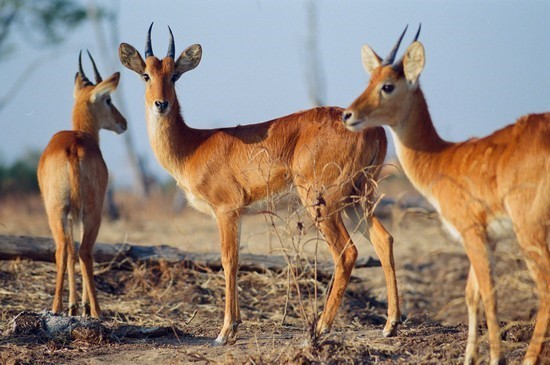 Kafue is Africa’s second-largest national park (the largest is
Namib-Naukluff in Namibia) but only draws about 15,000 visitors a year.
Kafue is Africa’s second-largest national park (the largest is
Namib-Naukluff in Namibia) but only draws about 15,000 visitors a year.
Puku, an antelope
generally found in wet grasslands, in North Luangwa National Park in Zambia, On
January 23, 2023.
We began at Ntemwa-Busanga Camp in the Busanga Plains, 587sq.km.
of grassland that floods during the rainy season. The immense landscape is
prime habitat for vast herds of wildebeest, Cape buffalo, zebra, roan and sable
antelope, and red lechwe, a gorgeous antelope with spiraling horns and huge
Disneyesque eyes. Warthogs and lions are abundant, and so are birds — from tiny
Bohm’s bee eaters, which look like winged emeralds, to imposing wattled cranes
with bright-red face masks.
Mercifully, our guide, Gilbert Chiwaya, was both knowledgeable
and a talker, quizzing us on obscure terms worthy of “Jeopardy.” (A group of
wildebeests? An
implausibility. A group of zebra? A dazzle.)
He also had a sixth sense about lion hangouts. We communed with
a collared female named Princess and her two daughters who were sleeping off a
kill under a sausage tree, named for the dangling fruits reminiscent of the
displays at old-school New York butcher shops. Earlier that morning, we
explored some lion droppings on foot, which smelled like 100 boxes of soiled
Kitty Litter. We sat transfixed watching impala long-jump over a stream.
This is not to say there were not comic moments. On a full-day
drive in Busanga, Chiwaya was forced to abandon his guests’ picnic lunches
after his vehicle was chased by a swarm of bees. And while savoring an
apple-tomato-carrot soup on a camp dining deck, our communal table was suddenly
overrun with biting red ants, necessitating a quick retreat to another spot.
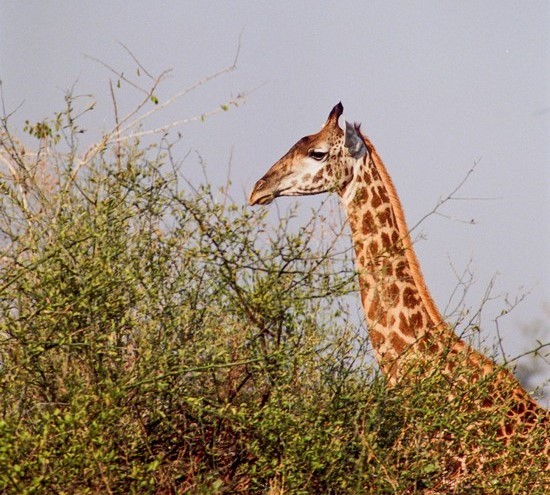 A giraffe grazes near
Tafika, a camp operated by Remote Africa, in South Luangwa National Park in
Zambia, On January 24, 2023.
A giraffe grazes near
Tafika, a camp operated by Remote Africa, in South Luangwa National Park in
Zambia, On January 24, 2023.
The ant incident occurred at Musekese Camp, which nevertheless
is an exquisite place overlooking a green lagoon teeming with wildlife. There’s
nothing quite like getting up from a nap to behold a large herd of elephants at
the water’s edge, drinking and lolling about in the mud.
On our final morning, we walked with Chiwaya, who told us about
a gigantic edible mushroom — sold on roadsides during the rainy season — that
is so big that “kids use them as umbrellas.” Then we headed back to the river
Chiwaya thinks of as “Mother Kafue.” He steered us upstream, pointing out a
massive crocodile whose tail glistened like chain mail in the late-afternoon
sun. Our destination was a sandbar known as “Skimmer Island,” a landing strip
of sorts for African skimmers, fantastical birds with bright-orange legs and
cupped orange beaks that allow them to scoop up fish on the surface of the
water.
As the birds flew into the sunset, their squawks reverberating
as they swooped, I felt a pang of longing for a country that felt difficult to
leave, a place where skimming the surface seemed like just the beginning.
Read more Travel
Jordan News









